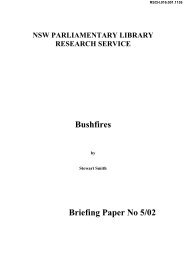Chapter 4 - Warnings - 2009 Victorian Bushfires Royal Commission
Chapter 4 - Warnings - 2009 Victorian Bushfires Royal Commission
Chapter 4 - Warnings - 2009 Victorian Bushfires Royal Commission
You also want an ePaper? Increase the reach of your titles
YUMPU automatically turns print PDFs into web optimized ePapers that Google loves.
<strong>2009</strong> <strong>Victorian</strong> <strong>Bushfires</strong> <strong>Royal</strong> <strong>Commission</strong>—Interim Report<br />
4 WARNINGS<br />
BUSHFIRE WARNINGS: THE WELL-TRODDEN PATH<br />
4.14<br />
4.15<br />
The review and analysis of warnings and their mode of delivery is not new. Successive inquiries, reviews<br />
and reports have considered bushfire warnings. Some have focused on warning content and construction,<br />
others on delivery systems.<br />
Some matters highlighted in these reports have received government support and been implemented.<br />
Others, in particular the national adoption of standard bushfire warnings and the development of a<br />
telephony-based warning system, received insufficient attention in the years after their recommendation.<br />
1984 Report on Ash Wednesday<br />
4.16 The 1984 inquiry into the 1983 Ash Wednesday fires produced a report, On Bushfire Disaster Preparedness<br />
and Response in Victoria. 9 That report noted the difference between warnings that simply raise general<br />
awareness and specific warnings about particular fires:<br />
… fire threat indicators which ushered in the 1982/1983 season served as a serious underscoring of the<br />
extreme risk facing authorities and communities alike. Whilst it is difficult to generalise with accuracy, it<br />
would appear that these indicators did help to enhance levels of awareness and preparedness. Whether<br />
this, in turn, had any significant effect on the disastrous circumstances of 16 February, is another matter. 10<br />
4.17<br />
4.18<br />
4.19<br />
4.20<br />
The Ash Wednesday report went on to address warning and information systems generally. It emphasised<br />
the importance of maximum warning lead time, accurate meteorological information, standardisation and<br />
clarity of warnings. It also explored the methods of providing information, such as special messages or<br />
warnings that alert people to switch to a designated system, such as the ABC. It found that greater use<br />
should be made of local TV and radio stations and that ‘Special fire warning sirens should be located at<br />
police and fire stations; also, church bells should be utilised’. 11<br />
The goal that warnings be standardised and their meaning rendered ‘clear and unambiguous’ was not fully<br />
achieved by 7 February. While sirens and church bells received specific attention in the report, the evidence<br />
before this <strong>Commission</strong> is that use of sirens was contrary to CFA policy on 7 February (further discussion<br />
at paragraph 4.224).<br />
The report emphasised the importance of informing the community about warning systems, and advising<br />
people about how to respond to them. It also recommended that ‘new systems which offer possibilities<br />
of enhancing warning capability should be examined’. 12<br />
These comments appear just as relevant today as when they were published in 1984. While new systems<br />
were indeed examined and kept under review in the years since 1984, the available technology for<br />
a telephony-based warning system was not used or introduced prior to the February <strong>2009</strong> fires.<br />
This represents a missed opportunity, and is addressed in more detail below.<br />
2002 COAG Report<br />
4.21 In 2002, the Council of Australian Governments (COAG) commissioned a review of Australia’s approach<br />
to dealing with natural disasters. The review was carried out by a high level group of officials representing<br />
all levels of government. The product of that review was a report titled, Natural Disasters in Australia —<br />
Reforming Mitigation, Relief and Recovery Arrangements .13<br />
4.22<br />
The report concluded that current arrangements ‘could be improved to ensure that Australia has a<br />
world class national framework for disaster management’. 14 Significantly, the report recommended what<br />
it described as ‘a paradigm shift to disaster mitigation’. It recommended the implementation of a Disaster<br />
Mitigation Australia Package, which would include funding for programs such as disaster warning systems<br />
and community awareness and readiness measures. 15<br />
122
















